Teacher shortages, student tracking, and mathematics education are intertwined issues that significantly impact the quality of education. In the context of K12 education, the current high-risk student tracking system has an unexpected connection with the shortage of teachers. Understanding this relationship is crucial for finding solutions to improve the educational landscape.

The Impact of Student Tracking on Teacher Allocation
Student tracking, the practice of sorting students into different groups based on various criteria such as academic performance, has a direct influence on teacher allocation. High-risk students, often placed in separate tracks, may require more individualized attention. This means that teachers assigned to these groups need to have specialized skills and more time for each student. As a result, schools may struggle to distribute teachers evenly across different tracks, leading to shortages in certain areas. For example, in mathematics education, if high-risk students are concentrated in one track, there may not be enough qualified math teachers to meet their needs. According to Education policy on Wikipedia, appropriate teacher allocation is a key factor in ensuring equal educational opportunities.
The Role of Rigid Tracking in Teacher Shortages
Rigid student tracking systems can exacerbate teacher shortages. When students are permanently placed in high-risk tracks, it creates a cycle where these tracks may be seen as less desirable by teachers. Teachers may prefer to teach in tracks with higher-performing students, believing they will have an easier teaching experience. This leads to a lack of teacher interest in high-risk tracks, further contributing to the shortage. In mathematics education, this can be particularly problematic as math is a subject that requires strong teaching support. As per Education on Britannica, flexible educational systems are more likely to attract and retain teachers.

To address these issues, it is essential to restructure the student tracking system. By creating a more flexible and inclusive tracking model, schools can better distribute teacher resources. This could involve periodic reevaluation of student placement, allowing students to move between tracks based on their progress. In mathematics education, this would ensure that high-risk students receive the necessary support from qualified teachers, while also preventing teacher shortages in other areas.
Readability guidance: In this article, we’ve explored the complex relationship between teacher shortages, student tracking, and mathematics education. By understanding these connections and implementing changes, we can work towards a more equitable and efficient education system.


